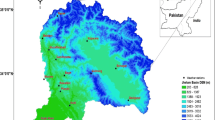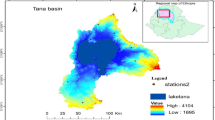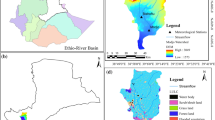Abstract
Downscaling of future projections of climatic variables from global climate models (GCMs) to urban catchment scales is required for stormwater studies as existing GCMs are unable to predict the rainfall at high temporal and spatial resolutions. In the current study, the capability of dynamical and statistical downscaling methods is evaluated and compared using the rainfall data of current climate and future extreme events at a small urban catchment scale. Regional climate model (RCM) and statistical downscaling model (SDSM) are utilized to downscale rainfall data from twelve GCMs under three representative concentration pathways (RCPs) (i.e., RCP2.6, RCP 4.5 and RCP 8.5). The daily rainfall data (1985–2015) of Lucas Creek catchment located in Auckland, New Zealand is used as a baseline/current climate. The future downscaled rainfall data is analyzed in the 2090s (2071–2100). The results showed that both the methods performed well in downscaling the current climate. For future projections, SDSM underestimated mean daily rainfall at the start of the annual cycle and overestimated towards the middle of the year compared to RCM. Similarly, monthly variance and skewness were overestimated for some months by SDSM. The GCMs of both the methods also showed variations in the future rainfall projections amongst themselves. However, significant alterations in the future rainfall were observed compared to the current climate. Rainfall frequency analysis was performed by applying the Gumbel distribution to the baseline and downscaled data for 1, 2, 3, 4, 5, 10, 20, 30, 50 and 100 years return periods. The investigation revealed that RCM and SDSM show similar results for low return periods and different results for high return periods for the current and future climate. Both the methods forecasted an increase in magnitudes of future events however, RCM projections were lower compared to SDSM. The results illustrate the downscaling abilities of both the methods at a small urban catchment scale however, the contrasting implication in downscaling the rainfall data is related to their different downscaling mechanisms.













Similar content being viewed by others
References
AC (2017) The unitary Auckland plan. Auckland Council, Auckland
Ahmed Shourav MS, Mohsenipour M, Alamgir M, Hadi Pour S, Ismail T (2016) Historical trends and future projection of climate at Dhaka city of Bangladesh. Jurnal Teknologi 78:69–75. https://doi.org/10.11113/jt.v78.9234
Arnaud P, Bouvier C, Cisneros L, Dominguez R (2002) Influence of rainfall spatial variability on flood prediction. J Hydrol 260:216–230. https://doi.org/10.1016/S0022-1694(01)00611-4
Azmat M, Qamar MU, Ahmed S, Shahid MA, Hussain E, Ahmad S, Khushnood RA (2018) Ensembling downscaling techniques and multiple GCMs to improve climate change predictions in cryosphere scarcely-gauged catchment. Water Resour Manage 32:3155–3174. https://doi.org/10.1007/s11269-018-1982-9
Boé J, Terray L, Habets F, Martin E (2007) Statistical and dynamical downscaling of the Seine basin climate for hydro-meteorological studies. Int J Climatol 27:1643–1655
Borges PDA, Barfus K, Weiss H, Bernhofer C (2017) Extended predictor screening, application and added value of statistical downscaling of a CMIP5 ensemble for single-site projections in Distrito Federal, Brazil. Int J Climatol 37:46–65. https://doi.org/10.1002/joc.4686
Carter JG, Cavan G, Connelly A, Guy S, Handley J, Kazmierczak A (2015) Climate change and the city: building capacity for urban adaptation. Prog Plan 95:1–66. https://doi.org/10.1016/j.progress.2013.08.001
DKRZ (2018) WDC climate. German Climate Computing Center. https://cera-www.dkrz.de/WDCC/ui/cerasearch/. Accessed 10 Jan 2019
El Adlouni S, Bobée B (2015) Hydrological frequency analysis using HYFRAN-PLUS software. https://www.wrpllc.com/books/HyfranPlus/hyfranplusdescrip.html
Emmanuel I, Andrieu H, Leblois E, Flahaut B (2012) Temporal and spatial variability of rainfall at the urban hydrological scale. J Hydrol 430–431:162–172. https://doi.org/10.1016/j.jhydrol.2012.02.013
Faurès J-M, Goodrich DC, Woolhiser DA, Sorooshian S (1995) Impact of small-scale spatial rainfall variability on runoff modeling. J Hydrol 173:309–326. https://doi.org/10.1016/0022-1694(95)02704-S
Fowler HJ, Blenkinsop S, Tebaldi C (2007) Linking climate change modelling to impacts studies: recent advances in downscaling techniques for hydrological modelling. Int J Climatol 27:1547–1578. https://doi.org/10.1002/joc.1556
Ghimire U, Srinivasan G, Agarwal A (2019) Assessment of rainfall bias correction techniques for improved hydrological simulation. Int J Climatol 39:2386–2399. https://doi.org/10.1002/joc.5959
GoCa (2017) CanESM2 predictors: CMIP5 experiments. Government of Canada. http://www.cccsn.ec.gc.ca/?page=pred-canesm2. Accessed 25 March 2017
GoCb (2018) Note on predictors (large scale atmospheric variables). Government of Canada. http://climate-scenarios.canada.ca/?page=pred-help. Accessed 14 April 2019
Gutmann ED et al (2012) A comparison of statistical and dynamical downscaling of winter precipitation over complex terrain. J Clim 25:262–281
Hasan A, Binti Pg DSNA, Ratnayake U, Shams S, Nayan ZBH, Rahman EKA (2018) Prediction of climate change in Brunei Darussalam using statistical downscaling model. Theor Appl Climatol 133:343–360. https://doi.org/10.1007/s00704-017-2172-z
Hashmi M, Shamseldin AY, Melville BW (2011) Comparison of SDSM and LARS-WG for simulation and downscaling of extreme precipitation events in a watershed. Stoch Env Res Risk Assess 25:475–484. https://doi.org/10.1007/s00477-010-0416-x
Hassan Z, Shamsudin S, Harun S (2014) Application of SDSM and LARS-WG for simulating and downscaling of rainfall and temperature. Theor Appl Climatol 116:243–257
Hellström C, Chen D, Achberger C, Räisänen J (2001) Comparison of climate change scenarios for Sweden based on statistical and dynamical downscaling of monthly precipitation. Clim Res 19:45–55
Huang J, Zhang J, Zhang Z, Xu C, Wang B, Yao J (2011) Estimation of future precipitation change in the Yangtze River basin by using statistical downscaling method. Stoch Env Res Risk Assess 25:781–792
Hunt A, Watkiss P (2011) Climate change impacts and adaptation in cities: a review of the literature. Clim Change 104:13–49
IPCC (2007) Climate change 2007: synthesis report. In: Contribution of working group I, II and III to the fourth assessment report of the intergovernmental panel on climate change. Intergovernmental Panel on Climate Change, Geneva, Switzerland
IPCC (2013) Climate change 2013: the physical science basis. In: Contribution of working group I to the fifth assessment report of the intergovernmental panel on climate change. Intergovernmental Panel on Climate Change, Cambridge, United Kingdom and New York, NY, USA
Jiang Y, Hou L, Shi T, Gui Q (2017) A review of urban planning research for climate change. Sustainability 9:2224
Kannan S, Ghosh S (2011) Prediction of daily rainfall state in a river basin using statistical downscaling from GCM output. Stoch Env Res Risk Assess 25:457–474. https://doi.org/10.1007/s00477-010-0415-y
LLNL (2018) CMIP5 data. Department of Energy, Lawrence Livermore National Laboratory. https://esgf-node.llnl.gov/projects/esgf-llnl/. Accessed 06 Jan 2019
Lorrey AM, Pearce PR, Barkus C, Anderson SJ, Clement-Jones A (2017) Auckland region climate change projections and impacts: summary report. National Institute of Water and Atmospheric Research (NIWA) for Auckland Council, Auckland, New Zealand
Masson V et al (2014) Adapting cities to climate change: a systemic modelling approach. Urban Clim 10:407–429. https://doi.org/10.1016/j.uclim.2014.03.004
McMahon TA, Peel MC, Karoly DJ (2015) Assessment of precipitation and temperature data from CMIP3 global climate models for hydrologic simulation. Hydrol Earth Syst Sci 19:361–377. https://doi.org/10.5194/hess-19-361-2015
MEa (2016) Climate change projections for New Zealand: atmosphere projections based on simulations from the IPCC fifth assessment. Ministry for the Environment, Wellington
MEb (2018) Climate change projections for New Zealand: atmosphere projections based on simulations from the IPCC fifth assessment, 2nd edn. Ministry for the Environment, Wellington
Molavi S, Muttil N, Tran HD (2011) Urban flood modelling and climate change: a Melbourne area case study. In: 19th International congress on modelling and simulation-sustaining our future: understanding and living with uncertainty (MODSIM2011), 2011. Modelling and Simulation Society of Australia and New Zealand Inc. (MSSANZ), pp 3608–3614
Moores J, Gadd J, Yalden S, Batstone S (2016) Urban development and the NPS-FM: Lucas Creek catchment case study. National Institute of Water and Atmospheric Research (NIWA) Ltd, Auckland
Murphy J (1999) An evaluation of statistical and dynamical techniques for downscaling local climate. J Clim 12:2256–2284. https://doi.org/10.1175/1520-0442(1999)012%3c2256:aeosad%3e2.0.co;2
Najafi MR, Moradkhani H, Wherry SA (2011) Statistical downscaling of precipitation using machine learning with optimal predictor selection. J Hydrol Eng 16:650–664. https://doi.org/10.1061/(ASCE)HE.1943-5584.0000355
Ouyang F, Lü H, Zhu Y, Zhang J, Yu Z, Chen X, Li M (2014) Uncertainty analysis of downscaling methods in assessing the influence of climate change on hydrology. Stoch Env Res Risk Assess 28:991–1010. https://doi.org/10.1007/s00477-013-0796-9
Raäisaänen J (2007) How reliable are climate models? Tellus A Dyn Meteorol Oceanogr 59:2–29. https://doi.org/10.1111/j.1600-0870.2006.00211.x
Rodgers JL, Nicewander WA (1988) Thirteen ways to look at the correlation coefficient. Am Stat 42:59–66. https://doi.org/10.2307/2685263
Rummukainen M (2010) State-of-the-art with regional climate models. Wiley Interdiscip Rev Clim Change 1:82–96
Schmidli J, Goodess CM, Frei C, Haylock MR, Hundecha Y, Ribalaygua J, Schmith T (2007) Statistical and dynamical downscaling of precipitation: an evaluation and comparison of scenarios for the European Alps. J Geophys Res Atmos. https://doi.org/10.1029/2005jd007026
Smith I, Chandler E (2010) Refining rainfall projections for the Murray Darling Basin of south-east Australia-the effect of sampling model results based on performance. Clim Change 102:377–393. https://doi.org/10.1007/s10584-009-9757-1
Sood A (2015) Improved bias corrected and downscaled regional climate model data for climate impact studies: validation and assessment for New Zealand. National Institute of Water and Atmospheric Research (NIWA), Wellington
Spak S, Holloway T, Lynn B, Goldberg R (2007) A comparison of statistical and dynamical downscaling for surface temperature in North America. J Geophys Res Atmos. https://doi.org/10.1029/2005jd006712
Su H, Xiong Z, Yan X, Dai X, Wei W (2017) Comparison of monthly rainfall generated from dynamical and statistical downscaling methods: a case study of the Heihe River Basin in China. Theor Appl Climatol 129:437–444. https://doi.org/10.1007/s00704-016-1771-4
Tang J, Niu X, Wang S, Gao H, Wang X, Wu J (2016) Statistical downscaling and dynamical downscaling of regional climate in China: present climate evaluations and future climate projections. J Geophys Res Atmos 121:2110–2129. https://doi.org/10.1002/2015JD023977
Tatsumi K, Oizumi T, Yamashiki Y (2014) Assessment of future precipitation indices in the Shikoku region using a statistical downscaling model. Stoch Env Res Risk Assess 28:1447–1464. https://doi.org/10.1007/s00477-014-0847-x
Wang X, Yang T, Shao Q, Acharya K, Wang W, Yu Z (2012) Statistical downscaling of extremes of precipitation and temperature and construction of their future scenarios in an elevated and cold zone. Stoch Env Res Risk Assess 26:405–418. https://doi.org/10.1007/s00477-011-0535-z
Wilby RL (2007) A review of climate change impacts on the built environment. Built Environ 33:31–45
Wilby RL (2015a) SDSM: data. https://sdsm.org.uk/data.html. Accessed 15 March 2017
Wilby RL (2015b) Statistical downscaling model: software. https://sdsm.org.uk/software.html. Accessed 15 March 2017
Wilby R, Dawson C (2007) SDSM 4.2—a decision support tool for the assessment of regional climate change impacts, user manual. Department of Geography, Lancaster University, Lancashire
Wilby RL et al (2000) Hydrological responses to dynamically and statistically downscaled climate model output. Geophys Res Lett 27:1199–1202
Wilby R, Dawson C, Barrow E (2002) SDSM—a decision support tool for the assessment of regional climate change impacts. Environ Modell Softw 17:145–157
Wilby R, Charles S, Zorita E, Timbal B, Whetton P, Mearns L (2004) Guidelines for use of climate scenarios developed from statistical downscaling methods. Supporting material of the intergovernmental panel on climate change, available from the DDC of IPCC TGCIA 27
Willems P, Arnbjerg-Nielsen K, Olsson J, Nguyen VTV (2012) Climate change impact assessment on urban rainfall extremes and urban drainage: methods and shortcomings. Atmos Res 103:106–118. https://doi.org/10.1016/j.atmosres.2011.04.003
Yoon JH, Ruby Leung L, Correia J (2012) Comparison of dynamically and statistically downscaled seasonal climate forecasts for the cold season over the United States. J Geophys Res Atmos 117:1–17. https://doi.org/10.1029/2012JD017650
Zhao P, Lü H, Yang H, Wang W, Fu G (2019) Impacts of climate change on hydrological droughts at basin scale: a case study of the Weihe River Basin, China. Quat Int. https://doi.org/10.1016/j.quaint.2019.02.022
Acknowledgements
We are grateful to the Auckland Council and the National Institute of Water and Atmospheric Research (NIWA), New Zealand for providing observed rainfall and geographical data of the Lucas Creek catchment, and rainfall projections for the Auckland region, respectively.
Author information
Authors and Affiliations
Corresponding author
Additional information
Publisher's Note
Springer Nature remains neutral with regard to jurisdictional claims in published maps and institutional affiliations.
Electronic supplementary material
Below is the link to the electronic supplementary material.
Rights and permissions
About this article
Cite this article
Akhter, M.S., Shamseldin, A.Y. & Melville, B.W. Comparison of dynamical and statistical rainfall downscaling of CMIP5 ensembles at a small urban catchment scale. Stoch Environ Res Risk Assess 33, 989–1012 (2019). https://doi.org/10.1007/s00477-019-01678-y
Published:
Issue Date:
DOI: https://doi.org/10.1007/s00477-019-01678-y




